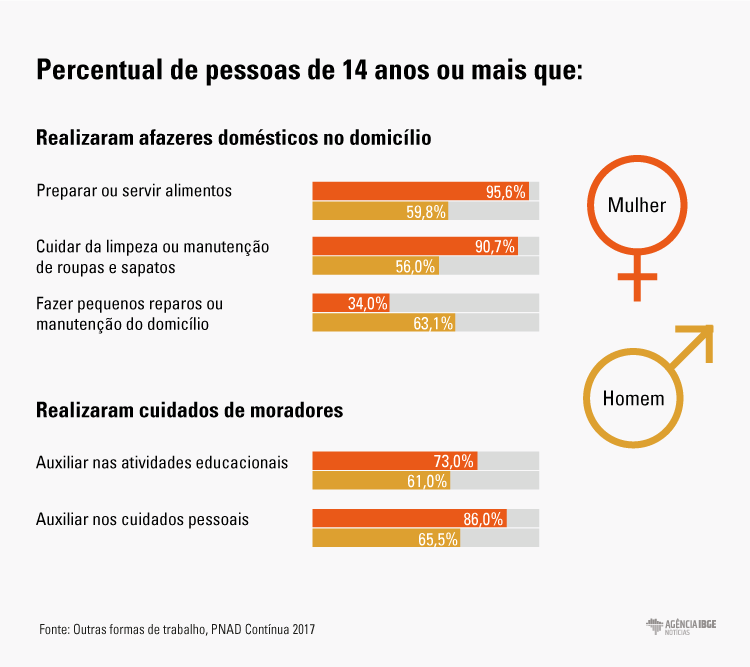Continuous PNAD
Women continue ahead of men in caretaking and household chores
April 18, 2018 10h00 AM | Last Updated: June 05, 2018 10h56 AM
In 2017, women continued to work 20.9 hours per week in household chores and in caretaking, almost twice as the 10.8 hours spent by men. Of the 88.2 million women aged 14 or over, 92.6% did these two activities last year, a slight increase compared to the 90.6% result in 2016. The proportion of men increased from 74.1% in 2016 to 78.7% of the 80.5 million males in this age group.
This information is in the module Other forms of work, of the Continuous National Household Sample Survey 2017 (Continuous PNAD), released today by the IBGE. The survey also collected data on subsistence production and voluntary work. Analyst Alessandra Brito, from Labor and Income, claims that these results show that "this aspect will take a little longer to reach a balance. It is a structural change that takes more time, it requires a change of mind. Everyone moved forward, but the proportion of women increased less because they already had a very high rate."

Differences are also relevant between employed and non-employed persons (unemployed or out of workforce). In this universe, employed women spent 7.8 hours more than men in domestic activities. Among the non-employed women, the difference jumps to 11.2 hours. According to Alessandra, "for men it does not make much difference whether he is employed or not, it makes more difference to women. When they are in the job market, they get fewer hours available to do their triple duty: caretaking, household chores and work. "
Alessandra pointed out that the Continuous PNAD allows us to identify some activities that were previously invisible: "there were works that were not measured. For example, if a person stops working to take care of a child, that kind of work is not priced, but hiring a nanny goes into the GDP account because there is a market value for it. The goal is that, at some point, this piece of information be considered in the System of National Accounts."

The survey also revealed that if, on the one hand, women have a high rate of household chores at all levels of schooling, on the other hand, men have a rate that ranges from 73% among uneducated persons or those with incomplete primary education, to 83.8% among those with complete higher education. For the IBGE analyst, the result "can be related to common sense, or even of child-rearing. Less educated men may find that household chores are a women's thing."
Male children and spouses had the highest rate of caretaking
A relevant change from 2016 to 2017 was the increase from 12.7% to 16.2% in the rate of caretaking of persons by children/stepchildren, and husbands/partners, from 27.5% to 34.7%. Among daughters/stepchildren, growth was from 25.9% to 30.2%, and between wives/partners, from 39% to 43.7%.

As for the rate of household chores, the highest among women was 97% for wives/partners, while among men, household heads were those who performed the most chores, 85%.
The survey also showed a great difference in the performance of domestic activities between men who lived alone and who shared the household with another person. While preparing/serving food and setting the table/dishwashing were the tasks performed by 91.8% of those living alone, for men sharing their homes, it falls to 57.3%. In the comparison between the sexes, the proportion of men is only greater than that of women in small repairs/maintenance of the home: 63.1% of them compared to 34% of them.




















